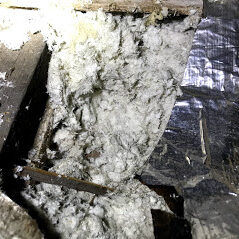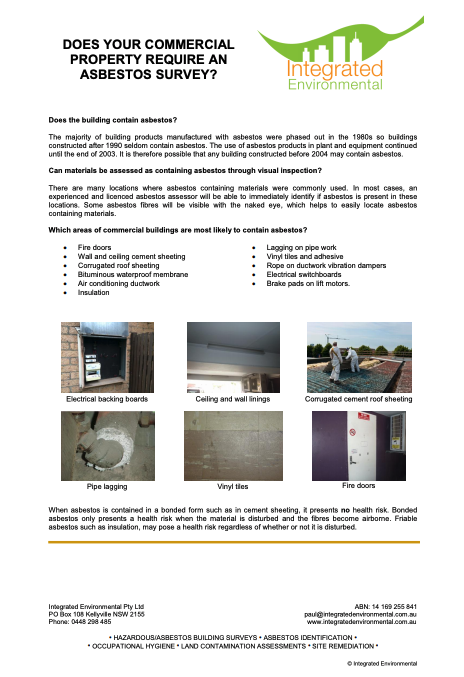Asbestos & Hazardous Materials Removal/ Management
Asbestos & Hazardous Materials Management – Safe, Professional, and Compliant Solutions
Asbestos and other hazardous materials pose serious health risks if not properly managed. At Integrated Environmental, we specialise in the safe identification, removal, and disposal of asbestos-containing materials, ensuring compliance with local and national regulations. Our team of certified professionals works diligently to protect your health and safety while minimising disruption to your home or business.

Loose fill asbestos insulation

Loose fill asbestos insulation testing

Loose fill asbestos insulation
Can materials be assessed as containing asbestos through visual inspection?
There are many locations where asbestos containing materials were commonly used. In most cases, an experienced and licenced asbestos assessor will be able to immediately identify if asbestos is present in these locations. Some asbestos fibres will be visible with the naked eye, which helps to easily locate asbestos containing materials.
Which areas of residential buildings are most likely to contain asbestos?
- Fire doors
- Wall and ceiling cement sheeting
- Corrugated roof sheeting
- Bituminous waterproof membrane
- Lagging on pipe work
- Vinyl tiles and adhesive
- Electrical switchboards
- Insulation






When asbestos is contained in a bonded form such as in cement sheeting, it presents no health risk. Bonded asbestos only presents a health risk when the material is disturbed and the fibres become airborne. Friable asbestos such as insulation, may pose a health risk regardless of whether or not it is disturbed.
Integrated Environmental is able to provide the following services:
-
- Asbestos and Hazardous Material Removal
- Hazardous/Asbestos Building Materials Registers
- Asbestos Removal Control Plans
- Air Monitoring for Hazardous Materials including asbestos
- Sample Analysis Services
- Asbestos Air Monitoring
- Clearance Certificates
- Lead Dust Removal
Service Breakdown
- Asbestos Surveys & Inspections “Our comprehensive asbestos surveys help identify asbestos-containing materials (ACMs) in residential, commercial, and industrial settings. We follow strict guidelines and use modern technology to ensure thorough inspections, providing you with a detailed report of any hazardous materials present.”
- Asbestos Removal & Disposal “We provide licensed and fully compliant asbestos removal services. Our team is trained to safely remove and dispose of asbestos in line with all state and federal regulations, ensuring the health and safety of occupants. We use specialised equipment and methods to minimise the risk of airborne asbestos fibres during removal.”
- Hazardous Materials Management “Beyond asbestos, we manage a wide range of hazardous materials such as lead, mercury, and mold. Our team has extensive experience in safely handling these materials, ensuring they are removed or contained with minimal risk to people and the environment.”
- Clearance Certificates & Air Monitoring “Post-removal, we conduct air quality monitoring to ensure your space is completely safe from asbestos contamination. We also provide clearance certificates to verify that your property meets health and safety standards before reoccupation.”
Why Choose Integrated Environmental?
- Certified and Licensed Experts: “Our team consists of fully licensed asbestos removalists with years of experience. We stay up-to-date with industry best practices and regulations to deliver the highest standard of service.”
- Health & Safety Focused: “We prioritise your health and safety at every stage of the process, from initial inspections to final air monitoring. Our meticulous attention to detail ensures that hazardous materials are handled safely and effectively.”
- Compliance Assurance: “All our asbestos and hazardous materials management services comply with Work Health and Safety (WHS) regulations and Safe Work Australia guidelines. We ensure that every project meets the highest standards for legal and safety compliance.”
- Tailored Solutions: “Every property is different, and so is every project. We tailor our asbestos removal plans to suit the specific needs of your property, ensuring the safest and most efficient approach.”
Concerned about asbestos or hazardous materials in your property? Contact Integrated Environmental today for a professional inspection and ensure your home or business is safe and compliant. Call us at 0448 298 485 or fill out our online form for a free consultation.
Not sure if you’re dealing with asbestos? Here’s a quick asbestos spotting guide for homeowners and property managers! Check out this video that covers key visual clues to help you identify potential asbestos-containing materials (ACMs) without the need for lab testing. Stay safe, stay informed on-site.
**Note: Always stay cautious while treating or handling any unknown material. Consider consulting with a licensed professional for safe handling and confirmation.
We are the Sydney experts in the following:
- Asbestos fire door testing and removal
- Lead paint testing and removal
- Asbestos removal from sheds and demolition
- Asbestos contaminated soil testing and removal
- Loose fill asbestos insulation testing
- Asbestos “Make Safe” on damaged materials
- Dumped asbestos testing and removal
- Lead dust removal

FAQs: What People Ask the Most
The asbestos air monitoring limit is typically set at <0.1 fibres/cubic centimeter of air over an 8-hour period or <0.01 fibres/mL. If levels exceed this limit, work should be halted, SafeWork should be notified, and the cause of the high exposure must be identified and rectified.
Asbestos health monitoring is typically conducted every two years, although frequency may vary based on regulations and individual risk assessments.
Reducing asbestos air pollution involves stopping its production and use, substituting with safer alternatives, and improving removal practices to prevent exposure. Additionally, early diagnosis and treatment of asbestos-related diseases, along with establishing exposure registries, are important steps as well.
Asbestos removal rules vary based on the area size and friability. For areas under 10 sqm non-friable, workers need asbestos awareness training and health monitoring.
For over 10 sqm non-friable, a Class B license is required, along with competent personnel for air monitoring and clearance inspection reports.
Friable asbestos demands a Class A license and a licensed assessor for monitoring and clearance reports before re-occupation.
In Australia, asbestos regulations are overseen by SafeWork NSW. They stipulate that non-friable asbestos removal, regardless of the area size, requires all workers to have asbestos awareness training and health monitoring.
For areas over 10sqm, a Class B license is necessary, along with a competent person for air monitoring and clearance inspection reports before re-occupation. Friable asbestos removal demands a Class A license and a licensed assessor for monitoring and clearance reports before re-occupation.
The guidelines for asbestos exposure include maintaining an LFAI register, a general asbestos register, and a management plan in workplaces where asbestos is present. These precautions are also recommended for homes suspected of containing asbestos.
Asbestos is a naturally occurring mineral that was widely used in construction materials for its fire-resistant properties. When disturbed, asbestos fibers can become airborne and inhaled, leading to serious health issues such as lung cancer, asbestosis, and mesothelioma.
The only way to confirm the presence of asbestos is through a professional asbestos inspection. If your property was built before the late 1980s, it’s more likely to contain asbestos materials.
Not always. In some cases, asbestos-containing materials that are in good condition may not pose an immediate risk. However, if the materials are damaged, friable, or if renovation work will disturb them, removal is necessary.


